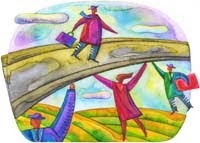"Winter" 15 feet tall, fiberglass
by Philip Haas
photo "Beauty and the Beast" by Dennis Roth
The National Gallery of Art in Washington, D.C. is currently presenting the works of Guiseppe Arcimboldo, a painter who served as the court painter and portraitist to both Maximilian II and, later, his son and successor, Rudolf II, in the Vienna of the Holy Roman Empire. He was born in Milan, the capital of Lombardy, in 1526, and did not leave the city until he was 36 years old-- a fact which clearly influenced his painting style, as "Lombardy is considered the cradle of naturalism, a mode of artistic expression based on the direct observation of nature and shaped by Leonardo da Vinci" (source: exhibition brochure of this show, by by Sylvia Ferino-Pagden). The 1500s were filled with exotic flora and fauna brought home from the travels of traders and explorers to Asia, Africa, and the New World, and the simultaneous rise of the new sciences of the Renaissance focused the interest of artists throughout Europe on careful study and depiction of the natural world.
Dürer's Rhinoceros, 1515
By Albrecht Dürer
The above print was created based on the sketch and notes of someone who had briefly seen the first such a creature to make it to Europe, in 1515. Unfortunately, the rhino died in a shipwreck before Dürer himself could see it, and it was 1577 before another rhinoceros made it that far. For that reason, the people of Europe thought--well into the 18th century-- that a rhino actually had scaly legs, rivets, and a horn on its back, though it does not. Later, the print would also serve to influence the surrealist Salvador Dali, who produced a sculptural version, shown below:
Rinoceronte vestido con puntillas (Rhinoceros dressed in lace)
1956, Salvador Dalí
As for da Vinci's influence on the era, and especially on Arcimboldo, his "grotesque" head of an old woman:
and old man:
have a clear structural similarity to the heads Arcimboldo would later create using fruits and vegetables, as well as various creatures. The exaggerated hooked nose, obscenely bulging forehead or extremely recessed chin all found their way into his odd portraits:
Water
by Arcimboldo
(Part of his series on the Four Elements, this painting is made up of mainly Mediterranean fish. According to the gallery notes, there are more than 60 different aquatic creatures here, the scale of which is inaccurate. Notice that the mouth is formed from a shark's jaw, and the eye is that of an ocean sunfish.)
Winter
by Arcimboldo
(The above is the painting from which Haas based his sculpture, shown at the top of this post.)
As a painter for Emperor Ferdinand I in Prague, he discovered the paintings of Peter Bruegel the Elder and Hieronymus Bosch, with their mixture of the bizarre and grotesque and their flawless attention to detail.
It is thought that his early studies of the natural world in the style of da Vinci were what attracted the attention of Maximilian II, who was an avid collector of animals and botanical studies, having created sensational zoological and botanical gardens at his court in Vienna. Arcimboldo would travel to Germany to buy both exotic creatures and man-made objects for his Kunstkammer, a precursor to modern museums, which under Maximilian's son, Rudolf, would come to be called the "Art and Wonder Chambers" (Source). The year after Arcimboldo arrived at the Viennese court, he created his allegorical paintings of the Four Seasons, including "Winter," shown above, which "appear to be an encyclopedia of the plants and animals that Maximilian acquired for his botanical garden and menagerie, all of which were studied by court scientists" (Source: exhibition notes). Replicas of the paintings and the accompanying poem by Giovanni Battist Fonteo which described them as allegories of the eternal rule of the Habsburg empire, were made and sent out as "propaganda" to other rulers.
Strangely, Arcimboldo's works were pretty much forgotten after his early death of kidney failure in 1593, but were rediscovered by Alfred H. Barr, a director of the Museum of Modern Art in New York, who included his paintings in an exhibition he put together in the 1930s called Fantastic Art, Dada, Surrealism. There, the mixture of serious study (for example, of botany) and humor, along with the obvious talent for invention and perceptual tricks, could be fully appreciated; he was soon dubbed "the arch-father of surrealism" by Dalí (Source), who would also go on to make heads out of pieces of the landscape, other body parts, and even magnified atoms.
The Librarian
by Arcimboldo
Still Life...
Flip the above still-life of a bowl of vegetables over, and you get this:
The Vegetable Gardener
But Arcimboldo's influence extends even further than that, right up to the modern day, as can be seen in the sculpture at the top of this post of his painting "Winter," created by Philip Haas for the National Gallery's current Arcimboldo show.
Philip Haas has an incredible talent for studying what's in front of him until he can re-create it, completely anew. In a 2009 show at the Kimbell Art Museum in Fort Worth Texas, he created 5 short films based on 5 paintings on display at that museum which took the viewer inside the world of the painting, or in the case below, inside the world of the painter's skull.
Skull Cinema for the moving Ensor painting by Philip Haas
"Skeletons Warming Themselves"
by James Ensor (1860-1949)
The film he made around the James Ensor painting "Skeletons Warming Themselves," (above) was shown via four screens inside a giant skull, and is described in the exhibition notes of the museum:
"In this piece Haas takes us inside the experiences, memories, and obsessive imagination of the Belgian painter James Ensor, author of the Kimbell’s macabre painting of the same title. The scene shifts from the artist lying dead in his studio to episodes in which he appears as an old man, as a young man, as a boy, and as a baby in the care of his heavy-drinking father. In a memory that stayed with him throughout his life, Ensor recalled an ominous bird flying into his room when he was still in the cradle. The family lived in the bleak seaside town of Ostend, where they ran a shop selling curios, bric-a-brac, and carnival masks. Haas shows Ensor at the carnival as a boy––with his grandmother—then later as a young man, each time encountering his father in a drunken state. In tableau vivant fashion, the carnival revelers enact scenes familiar from his paintings, with their grim repertoire of masks, skulls, and skeletons––all captured vividly thanks to the theatrical designer Julian Crouch, with whom Haas worked on the masks and sets. We also see the young Ensor setting up and painting Skeletons Warming Themselves in his studio. The film features some distinguished veterans of the British acting world, Bernard Horsfall as the old Ensor, Clive Russell as the father, and Paola Dionisotti as the grandmother."
Self-Portrait with Masks, Ensor
Recreation of Ensor's Self-Portrait with Masks for the film by Philip Haas
You can see a brief clip from the film here.
"Young James Ensor at Mardi Gras Court"
by Philip Haas
The D.C. Arcimboldo show will run through January 9, 2011. Thanks to Dennis Roth for the heads-up.



































